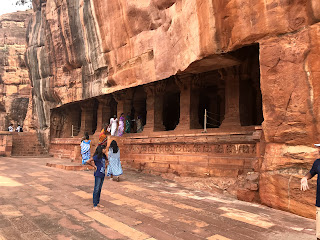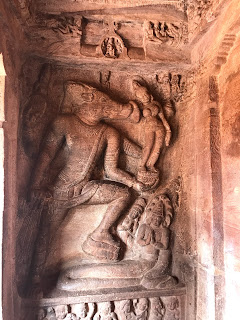Anyone who has read 'Sivagamiyin sabatham' needs no introduction to Badami - or the more familiar name Vathapi. The book is not my favorite piece of fiction or not even my favorite by Kalki. But I read it initially as a story and then at a later point realized that the story actually happened. It is one of my first introduction to the Pallavas and the fiction reading transformed into history reading and then actually visiting the places where these stories happened.
'Sivagamiyin sabatham' - in spite of the fact that the central figure in the drama, Sivagami, is a fictional character, gor a lot of things in relation to history correct. Kalki does not depict Pulikeshin II as a villain but rather someone at odds with himself. His expansionist ambitions versus his love for art is what plays out in the novel. Although I find the writing in this novel to be tedious, the history is wonderful.
So it is how I was consumed by the wish to visit Vatapi at least once. Not only to see the erstwhile kingdom which challenged the Pallavas, but the artistic accomplishments of the Chalukyas itself. On that day, I already had seen Aihole and Pattadakal and needed no convincing about the accomplishments anyway.
I kept going back to the fact that these two emperors - Pulikeshin II and Narasimhavarman - traversed the entire landscape of the Deccan , with large armies, in hot weather and mind boggling logistics, to satisfy their vanity, under guises of revenge and expansion. It is difficult to do it in trains and cars these days.
The story of Pulikeshin II's attempt at capturing Kanchi during Mahendravarman's reign and the subsequent movement of Narasimhavarman to capture Vatapi and take revenge on Pulikeshin is well-known. The Pallavas - under Narasimhavarman and his able general, Paranjyoti - captured Vatapi and held it under occupation for 13 years, before Vikramatiya took it back. By that time, Narasimhavarman exits the stage and the Pallavas go into turmoil during the succession period. Vikramaditya takes his revenge by capturing Kanchi himself.
When the Pallavas held Vatapi, it is said that they erected a victory pillar and it was destroyed by Vikramatiya when he took over. The only remaining proof of this occupation is the inscription by Narasimhavarman in the rock surfaces back of the Mallikarjuna temple. This is what I wanted to see.
Badami today is a small town with bad roads and still badly built houses and shops. The town was completely in grips of traffic chaos even in the middle of the day and is difficult to negotiate the lanes that lead to the main archeological centers of Badami, the Badami caves.
It is said that Pulikeshin II spent some time in the Ellora caves and came back to Vatapi, determined to replicate its splendor. The Badami caves, four in number, carved one above the other, have sculptures which again can compete with any other sculptures from the same time period and one can clearly see the continuity of the tradition from Ellora in all the caves.
What is also surprising is that this is the same period in the Pallava kingdom, where Mahendravarman and Narasimhavarman were busy with their cave temples. And the similarity between the ones in Badami and the Pallavas cave temples is again, astonishing. It is the only thing that kept coming into mind as we keep traveling into these areas. As much as the language and other differences exist between these areas, the similarities are as much as well.
Of the 4 cave temples, one is Jain and the first three are Hindu. The sculptures and the Chaitya style halls in the caves are more elaborate. While the sculptures are exemplary, there is none that compares to the Mahishasuramardhini panel in Mahabalipuram. However, I would say, the size of the caves with the large halls cannot be compared to the smaller Pallava caves.
The caves also offer a panoramic view of the city below. The Agastya theertham pond and the temples that surround it looks like a different world from above in the hillocks. While we were there, the weather changed suddenly and after a spat of cold winds, it started drizzling and if there was heaven on Earth, it was that place at that time.
So, it was off to find the Pallava inscription after the caves and we found that we have to walk around the Agastya theertham and there is no way the car can get into those by-lanes. By the time we started walking to the Mallikarjuna temple on the other side, the wind picked up and it slowly started raining. It was such fun to get wet and walk towards this picturesque place.
We reached the ASI museum near the Mallikarjuna temple and started inquiring about the location of this inscription. That's when we found that the inscription is in a rock boulder in the hillock near the museum and reaching it is going to involve climbing rocks and then as well, its gonna be difficult in the rain, that was picking up at that time. That also explained why I could not find a picture of this inscription in the net with all kind of searches. So, it was with disappointment that we left the place to visit the Mallikarjuna temple and the Bhootnatha temple. So it was that I decided to start searching for the inscription by Vikramaditya in the Kailasanatha temple in Kanchi.
Both the temples have a fantastically picturesque location and in that evening with dark clouds and incessant rain, they look like a places in a different world altogether. They are small temples with the Chalukyan sculptures and the Bhootnath temple has a distinct Dravidian style and the location jutting into the Agastya theertham look absolutely gorgeous.
The temples are not to be missed and we were told that there are hillocks all around full of smaller places of Jain and Chalukyan sculptures and there are small temples in the hills and the fort structures can be seen as well.
Badami/Vatapi , though seem like a little touristy place, it probably need 3-4 days to see in completion - especially along with Pattadakal and Aihole. I just wished we had more time to spend in these treasure trove of places to see and take it in full.
So it was after a very eventful day, in perfectly beautiful weather, we drove back to Hampi to continue the exploration of the place we left midway.
 |
| The hills of Badami - The caves can be seen |
 |
| View from the caves, the Agastya theertham and the temples on the other side |
 |
| Cave 1 |
 |
| Harihara Panel |
 |
| Varaha - Vishnu and the Royal emblem (Cave 2) |
 |
| TriVikrama panel |
 |
| Ardhanarishwara panel |
 |
| Couple in love - Cave 3 |
 |
| Chaitya style hall - Cave 3 |
 |
| Parasvanath (Jain Tirthangara) - Cave 4 |
 |
| The 23 Tirthangara panel |
We reached the ASI museum near the Mallikarjuna temple and started inquiring about the location of this inscription. That's when we found that the inscription is in a rock boulder in the hillock near the museum and reaching it is going to involve climbing rocks and then as well, its gonna be difficult in the rain, that was picking up at that time. That also explained why I could not find a picture of this inscription in the net with all kind of searches. So, it was with disappointment that we left the place to visit the Mallikarjuna temple and the Bhootnatha temple. So it was that I decided to start searching for the inscription by Vikramaditya in the Kailasanatha temple in Kanchi.
Both the temples have a fantastically picturesque location and in that evening with dark clouds and incessant rain, they look like a places in a different world altogether. They are small temples with the Chalukyan sculptures and the Bhootnath temple has a distinct Dravidian style and the location jutting into the Agastya theertham look absolutely gorgeous.
 |
| Royal couple |
 |
| Bhootnath Temple |
 |
| The Dravida sigara - against the rain clouds |



No comments:
Post a Comment